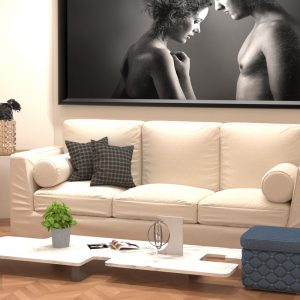-
 Living Room Sofa$999.99
Living Room Sofa$999.99
Designing a minimalist dining room involves creating a clean, functional, and visually pleasing space that focuses on essential elements. Here’s a guide on how to achieve a minimalist dining room:
- Neutral Color Scheme: Start with a neutral color palette such as whites, grays, or muted tones. This provides a clean and timeless backdrop for the entire room.
- Simple Furniture: Choose a sleek and straightforward dining table and chairs. Opt for clean lines and minimal detailing. Consider materials like wood, metal, or glass for a modern and uncluttered look.
- Limited Decor: Keep decor minimal and purposeful. Consider a single centerpiece or a few carefully selected items that add visual interest without overwhelming the space. A minimalist pendant light above the dining table can serve as both a functional and decorative element.
- Functional Storage: Integrate storage solutions to keep dining essentials organized. Buffets or sideboards with clean lines can offer discreet storage for dinnerware, linens, and other items.
- Open Space: Allow for open space around the dining table. Avoid overcrowding the room with unnecessary furniture, creating an airy and spacious feel. This also facilitates ease of movement during meals.
- Quality Tableware: Invest in high-quality, simple tableware. White or neutral-colored plates and minimalist flatware complement the overall aesthetic and contribute to a refined dining experience.
- Natural Elements: Bring in natural elements to add warmth. Consider incorporating wooden elements in furniture or decor, and perhaps introduce indoor plants to bring a touch of nature into the room.
- Large Windows or Minimal Window Treatments: Maximize natural light or use minimal window treatments to allow ample light into the dining room. This enhances the sense of openness and contributes to a bright and inviting atmosphere.
- Artful Display: If you choose to display artwork, opt for a single, impactful piece or a curated collection with a cohesive theme. Minimalist art with clean lines and neutral colors can complement the overall design.
- Functional Layout: Arrange furniture in a way that promotes conversation and facilitates a smooth flow. Consider the placement of the dining table in relation to other elements in the room to create a harmonious and functional layout.
Remember, the essence of a minimalist dining room is simplicity and purpose. Each element should serve a specific function and contribute to an uncluttered, sophisticated space that promotes a serene dining experience.

